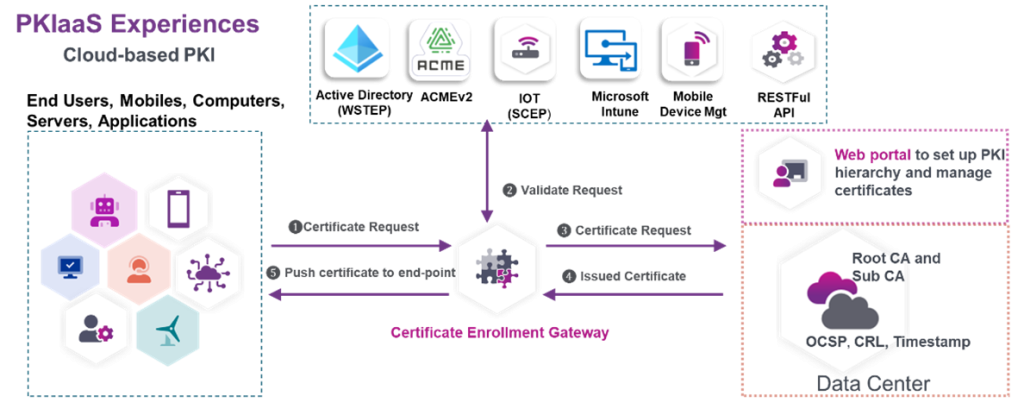The public key infrastructure (PKI) is a widely accepted standard in the security industry and the foundation of trust and secure digital communication across various applications, from websites’ SSL/TLS and document signing to secure email and remote work.
As organisations become more dependent on PKI (Public Key Infrastructure) for their day-to-day activities, setting up and maintaining their on-premises PKI to manage certificates can be a complex and demanding task over time. PKI is no longer limited to a few use cases like encrypted email or network access. Instead, PKI is now used to secure a wide array of technologies, including mobile devices, the Internet of Things (IoT), DevOps, and a growing number of API-connected services.
What Are the Challenges of On-premise-Based PKI
High Cost of ownership. On-premises PKI requires a significant upfront investment of resources in software/hardware systems (such as servers and hardware security modules), physical facilities, and skilled PKI staff to design, operate, and secure the PKI infrastructure.
Operational and Security Risk. As organisations expand their use of PKI, the on-premises PKI can become increasingly difficult to manage over time. This is often due to the deployment of multiple certificate authorities (CAs), which can lead to operational overhead and security risks, with no clear ownership of who is responsible for managing the CAs. This situation can result in misconfiguration, human errors, and delays in applying critical updates to address vulnerabilities.
Manual Certificate Lifecycle Management On-premises PKI lacks integrated automation, monitoring, reporting, and alert notification. This means that manual processes must be used to manage large numbers of certificates. Manually monitoring and managing high volumes of certificates is highly inefficient and susceptible to errors.
Lack of Scalability. As an organisation’s PKI expands to include more users, devices, and applications, the number of certificates to manage can increase exponentially. On-premises PKI solutions lack the scalability to accommodate this growth, often requiring extensive planning, significant resources, and substantial hardware investments to expand infrastructure. Failure to scale out, the PKI infrastructure becomes a bottleneck, slowing down operations and impacting user experience.
Considering the above challenges of on-premises PKI, a cloud-based PKI solution simplifies the deployment process and lowers the cost of implementing PKI. Additionally, a cloud-based PKI approach allows organisations to more easily expand the use of PKI to meet evolving business needs.
What is PKIaaS

Public Key Infrastructure as a Service (PKIaaS) is a cloud-based PKI service that provides functions of public key infrastructure (PKI) without the need to build or manage the PKI infrastructure. By outsourcing costly investment in PKI infrastructure, the time-consuming and resource-demanding task of managing a PKI in-house to a PKI provider, PKIaaS reduces the operational complexity and cost associated with managing PKI infrastructure.
Benefits of PKIaaS
PKIaaS offers numerous benefits to organisations:
Reduced costs: PKIaaS can help organisations save on initial and ongoing costs by eliminating the need to purchase and maintain the hardware, software, and skilled personnel required for PKI infrastructure. Instead, PKIaaS offers these services through a monthly subscription fee, which makes the costs much more predictable, as the various hidden and in-house expenses associated with running a PKI are replaced by a flat-rate billing model.
Increased Operational efficiency: PKIaaS offers a centralised view of the entire PKI operations, providing organisations with control over all their certificates under a consistent policy framework. This centralised management approach helps reduce the time and effort needed for administrative tasks, minimise human errors, and streamline compliance checks. As a result, organisations can experience a substantial improvement in their overall operational efficiency.
Increased resiliency. PKIaaS solutions are designed with redundancy and failover capabilities, utilising geographically distributed data centres. This ensures that the PKI solutions remain continuously available in the event of a system failure. Implementing redundancy and failover capabilities can be challenging and costly for most organisations on their premises.
Increased security compliance. PKIaaS ensures the security of an organisation’s PKI by operating the PKI infrastructure with industry best practices and compliance requirements such as GDPR, HIPAA, and PCI DSS. This helps to minimise and manage any potential security risks. Additionally, PKIaaS rapidly delivers consistent updates to critical software patches and ensures adherence to the latest security policies and procedures, thereby providing a secure and current PKI solution.
Highly scalable: PKIaaS can rapidly scale its services to accommodate the evolving needs of an organisation, without any additional investment in hardware or software. With PKIaaS, organisations can create multiple certification authorities in a matter of minutes, rather than weeks or months.
Automated Certificate Lifecycle Management. PKIaaS simplifies certificate management from issuance to renewal and revocation by automating the deployment and lifecycle of certificates issued to devices or users via standard protocols and APIs. This substantially reduces the time and effort dedicated to manual processes, and also minimises the possibility of human mistakes.
Manage PKI Operations with PKIaaS
PKIaaS platforms are designed to provide a centralised platform that acts as a single view for all PKI activities, from deploying Certificate Authorities (CAs), monitoring, reporting, to managing all certificates issued from the CAs with the following key features:
Deploy a multi-tiered Root/Subordinate certificate authority (CA) trust hierarchy and offer multiple certificate types such as TLS certificates, S/MIME or code signing. Core PKI services, such as CRL (Certificate Revocation List) and OCSP (Online Certificate Status Protocol), are provided to facilitate certificate validation.
Automation support for certificate lifecycle management.
Detailed views of certificates across CAs. Acts as a single source of multiple CAs and views the status of all certificates.
Reporting and monitoring. Generate reports on certificate usage, expiration and monitor the operational health of PKI components.
Enforce policies. Establish and apply uniform security policies for all certificates across the entire organisation, including key length, certificate profiles, and access controls. This will help mitigate the risks associated with human errors and misconfiguration.
Role-Based Access. Assign tasks to various teams, granting them specific permissions to ensure that only authorised individuals can carry out particular PKI-related activities.
Automate Certificate Management with PKIaaS
PKIaaS is highly automated in managing the lifecycle of certificates. When a certificate is nearing its expiration date, PKIaaS automatically renew the old certificate and issues a new one, ensuring a seamless transition and distribution of the updated certificate.
The PKIaaS turnkey integration solution offers organisations a variety of options to automate the distribution and administration of certificates, including:
- Microsoft certificate autoenrollment protocols (WSTEP) for Windows Active Directory users and computers.
- ACMEv2 (Automatic Certificate Management Environment) to automate certificate management for web services or APIs.
- SCEP (Simple Certificate Enrolment Protocol) and MDM (Mobile Device Management) to automate certificate management with Routers, firewalls, IoT communication, Microsoft Intune, Google MDM, VMware Workspace ONE and Jamf MDM.
- RESTful API-driven automation to integrate with third-party or custom applications for various use cases such as TLS/mTLS certificates for containers orchestration systems and DevOps tools.
With Certificate Enrolment Gateway (CEG) services, PKIaaS platforms support standard certificate enrolment protocols like SCEP, ACME, or MDM. The CEG acts as a gateway connecting with protocols such as WSTEP, SCEP, ACME, MDM, and RESTful API to accept certificate requests from endpoints and then transmit them to the cloud-hosted Certificate Authority (CA) to automate the management of the certificate lifecycle.

In Conclusion
PKI plays a critical role in ensuring secure digital communication, a strong authentication mechanism and data protection within the organisational environment. However, efficiently managing a PKI solution can be challenging due to the associated costs and complexities involved in supporting and securing the PKI infrastructure.
With a PKIaaS (PKI as a Service), organisations no longer need to handle the complex tasks of setting up, configuring, and managing their own PKI infrastructure. PKIaaS is designed to be highly scalable, allowing it to grow with demand, continuously monitor the PKI environment, and automate certificate lifecycle management. This enables organisations to improve the security and efficiency of their PKI.
Considering the benefits of PKIaaS, it is advisable to evaluate implementing a PKIaaS solution within your organisation. If you have any questions about PKIaaS, please don’t hesitate to contact the Netrust Sales team at https://www.netrust.net/contact-us/ to find out more.
Interested in learning more about effortless Provisioning? Check out this related blog here:
Effortless Provisioning: Deploying Certificates to Web Servers
Follow us on LinkedIn for the latest happenings/updates.


